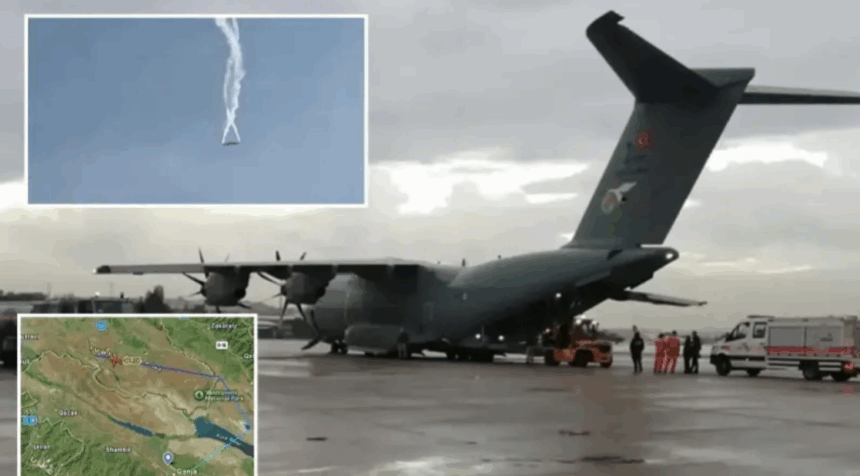Video footage captured by onlookers appears to show the Turkish Air Force C-130E spiraling downward from the sky in multiple pieces, leaving a trail of white vapor or smoke in its wake. The hulking four-engined cargo plane – callsign TUAF543 – had been cruising at 24,000 feet on a routine flight home when disaster struck without warning. In an instant, this cold Tuesday morning over the Caucasus turned into a scene of horror: witnesses watched in shock as the aircraft’s central fuselage and wings tumbled almost intact in a deadly corkscrew, while other sections – the tail, the nose – sheared off and fell separately toward the Georgian countryside. Moments later, a blossom of black smoke on the horizon marked the impact site. There had been no distress call, no hint from the crew that anything was amiss before the mid-air breakup. Twenty souls were aboard the C-130; none survived. And as rescue teams descended on the wreckage in Georgia’s Sighnaghi region, only a few kilometers from the Azerbaijani border, a pressing question hung in the air: Was this merely a tragic accident – or could some external intervention have ripped this aircraft from the sky?
All official statements so far refrain from speculation. Turkey’s Ministry of Defense confirmed the loss of the C-130E Hercules transport, which had departed Ganja, Azerbaijan at 10:19 UTC en route back to Turkey. Georgian authorities said the plane vanished from radar shortly after entering Georgian airspace and crashed in the Kakheti highlands, roughly 5 km from the Azeri frontier. There was no mayday signal before the sudden disappearance. By early evening on November 11, sobering images of the crash site began emerging: twisted metal scattered across remote hills, and, as one Georgian outlet noted, holes puncturing pieces of the wreckage. Turkey’s President Recep Tayyip Erdoğan offered prayers for the “martyrs” lost and vowed to “overcome this accident with the least amount of setbacks possible,” while Azeri and Georgian officials sent condolences. The immediate assumption might be an accident – catastrophic mechanical failure or pilot error. Yet the manner of this crash, a mid-air disintegration in calm flight, is so rare and jarring that it has inevitably spurred darker theories. Could an on-board explosion, sabotage or even a missile attack have torn apart TUAF543? In today’s geopolitical climate, the idea is not as far-fetched as it might initially sound.
The forensic clues tell a perplexing story. The Lockheed C-130 is an exceedingly rugged aircraft – a four-engine turboprop workhorse with a reputation for reliability in war and peace. Turkey’s C-130E fleet dates back to the 1960s, and the particular aircraft that went down (tail number 68-01609) was 56 years old, originally delivered to the Saudi Air Force in the late ’60s before Turkey acquired it in 2010. Old, yes, but it was also one of the planes upgraded under an ambitious “Erciyes” modernization program to extend the lifespan of Turkey’s Hercules fleet well into the 2040s. The Erciyes upgrade refitted these C-130B/E models with modern avionics, navigation systems and cockpit displays, renewing their capabilities. In other words, the ill-fated aircraft was technologically updated and presumably well-maintained. Even so, age takes a toll on any airframe. Analysts immediately pointed out that metal fatigue could have played a role – hairline structural cracks that go unseen until they trigger a failure. In fact, an eerie precedent occurred in 2017, when a U.S. Marine Corps KC-130 broke apart mid-air due to a ruptured propeller blade slicing into the fuselage; investigators blamed unseen corrosion and fatigue in that case. Could something similar – a spontaneous structural failure – have torn open the Turkish C-130 at 24,000 feet? Perhaps a crucial component gave way: a wing spar snapping, an engine propeller exploding, or the pressure hull cracking catastrophically. Yet here’s where the puzzle deepens: eyewitness video suggests the wings stayed attached to the center fuselage as it fell. In a plane of this vintage, one might expect the wings to be a critical failure point, yet they remained largely intact with the main wing box even as the tail and nose were gone. That pattern hints that the initial break may not have been a simple wing-spar failure or other age-related crack – instead, the fuselage itself shattered apart in flight. The breakup appears to have cleaved the Hercules into major sections: a front portion (cockpit and forward cargo hold), and an aft section (rear cargo hold and tail), separating from the wing-center section. For such a violent sundering to occur without any obvious weather or pilot inputs, something sudden and forceful almost certainly occurred.
Investigators will comb the debris for telltale forensic evidence. Were metal edges bent outward by an internal blast, or inward by an external impact? Are there residue traces of explosives on the wreckage? Already, unconfirmed whispers on social media point to unusual perforations – “delikler” (holes) – in recovered airframe pieces, prompting fevered speculation of shrapnel damage. No official source has corroborated that, and it’s possible such holes are simply the result of structural tearing. Still, the mere suggestion set the “sabotage” rumor mill in motion online. Georgian investigators and Turkish military teams will be conducting a painstaking examination to reconstruct the sequence of failure. Flight data will be crucial as well: the ADS-B track from Flightradar24 shows the C-130 climbing steadily from takeoff in Ganja (at 10:19 UTC) up to cruising altitude by about 10:41 UTC, then maintaining a normal course westward into Georgia. The last recorded data point was around 10:48 UTC at FL240, after which the plane abruptly vanished from radar. Whatever happened, happened fast. The breakup happened at FL240 in level flight with no signs of distress beforehand. That timing suggests the C-130 was not maneuvering heavily or entering any known hazard; it was on a routine transit, presumably on autopilot, when calamity hit out of the blue.
So, what could bring down a sturdy military transport in such a fashion? Accident scenarios include a sudden, devastating mechanical malfunction – for example, a propeller or engine explosion that sent debris ripping through the fuselage. A fire or explosion in the cargo bay (perhaps dangerous goods igniting) could likewise cause an instantaneous breakup. There is also a theory of cargo shifting: if the cargo or vehicle being carried wasn’t properly secured, it might break loose and slam into the airframe from within, though that usually doesn’t cause an in-flight disintegration as much as a loss of control. Investigators are reportedly looking at whether improper loading or balance could have induced severe vibrations or structural stress. Yet these explanations, while possible, feel a bit unsatisfying given the dramatic imagery of the event. Typically, a mechanical problem – say an engine fire – would lead to a distress call or some controlled descent. Here, we see a sudden violent break-up. That inevitably raises the possibility of an explosive event – either a catastrophic fuel vapor ignition, a bomb, or a missile strike.
One cannot ignore the broader context. The C-130 went down in a geopolitically tense corridor, essentially at the tri-point of Turkey, Azerbaijan, and Georgia’s interests – and uncomfortably close to Russia’s sphere of influence. The South Caucasus has been a theater of shadowy conflict and covert operations, especially following the recent Nagorno-Karabakh war. Turkey and its ally Azerbaijan emerged victorious in that conflict, while Russia – traditionally the power broker in the Caucasus – saw its influence wane. Just weeks ago, on November 8, President Erdoğan stood in Baku alongside Azerbaijan’s president to celebrate their 2020 victory. In the wake of Azerbaijan’s lightning offensive that recaptured Karabakh from Armenian separatists (an operation from which Russian “peacekeepers” stood aside), Moscow’s relationship with Ankara has grown more complex and fraught. Though Turkey maintains a curious balancing act between NATO and Moscow, there’s no doubt that Russian-Turkish tensions have been on the rise in late 2024 and 2025. Turkey’s recent diplomatic moves have tilted it back toward its Western allies: after long resistance, Ankara finally approved Sweden’s accession to NATO, much to the Kremlin’s irritation. Even more pointedly, just two weeks before the crash, Turkey signed a multibillion-dollar deal to purchase Eurofighter Typhoon jets from the UK – a NATO ally – marking a significant boost to Turkey’s Western defense ties and capabilities. Russian officials surely noticed that Turkey is enjoying its warmest ties with the West in years. Moscow openly fumed at NATO’s expansion and Ankara’s role in it. Moreover, since 2022, Ankara has also tilted against Moscow in the Black Sea war: it backed Kyiv politically, enabled the transfer and sustainment of Bayraktar TB2 drones that mauled Russian armor early in the campaign, and invoked the Montreux Convention to close the Bosporus and Dardanelles to belligerent warships—constraining Russia’s ability to rotate naval units between the Mediterranean and the Black Sea. Set against that history, a reverse scenario—Russia downing a Turkish aircraft—would not be unprecedented in its lethality and would sharply test allied resolve
Add to that the Syrian theater has flipped since the regime’s collapse on December 8, 2024, when an opposition offensive—with political cover from Ankara and Western partners—pushed Bashar al-Assad from power. Ahmed al-Sharaa (Abu Mohammad al-Julani), now leading the transitional government, has moved quickly to normalize ties with Washington and Ankara; on November 10, 2025 he became the first Syrian leader to be received at the White House, a meeting that coincided with the potential complete removal of U.S. sanctions and early discussions of reconstruction channels.
This is the uncomfortable backdrop against which the sabotage hypothesis arises. Could the Kremlin or its proxies have decided to send a message by striking a Turkish military plane? It wouldn’t be without precedent. Russia has a shadowy track record of covert air sabotage and deniable strikes, dating back decades and revived in recent years. One immediately recalls the mysterious plane crash that killed Wagner mercenary chief Yevgeny Prigozhin in August 2023 – a crash U.S. intelligence believes was caused by an intentional explosion on board, quite likely an assassination ordered from the highest levels in Moscow. The Kremlin, of course, denied direct involvement even as it obliquely acknowledged Prigozhin may have been “downed on purpose”. The destruction of Malaysia Airlines Flight MH17 over eastern Ukraine in 2014 is another stark example: a civilian airliner blasted out of the sky by a Russian-made BUK surface-to-air missile, fired by a Russian Army unit or separatist forces under Moscow’s command. Nearly 300 innocent people died in that tragedy, and Moscow spent years spinning disinformation before international investigations definitively pointed at Russian culpability. And going further back, many Poles to this day believe that the 2010 plane crash in Smolensk that killed Poland’s President Lech Kaczyński was no ordinary accident but a Russian sabotage operation. In 2022 a Polish government commission even claimed to have evidence of two explosions on board that Tu-154 aircraft, calling the Smolensk disaster “an act of unlawful interference by the Russian side”. (Russian authorities have always vehemently rejected that charge, and official investigations cited pilot error and fog – yet the suspicions linger, illustrating how whenever high-profile planes crash near Russia, questions of foul play arise).
What about more directly comparable incidents around the Caucasus? Here, truth can be stranger than fiction. Consider what happened on Christmas Day 2024: Azerbaijan Airlines Flight J2-8243, an Embraer passenger jet, was flying from Baku when it encountered Russian air-defense activity near Grozny. According to a Ukrainian intelligence official, Russian forces mistakenly shot at the airliner, which limped across the Caspian and crash-landed in Kazakhstan with dozens dead or injured. In a surreal twist, even Vladimir Putin eventually admitted that a Russian missile caused that plane’s demise. If true, it’s a chilling reminder that Russian trigger fingers in the region can be itchy and lethal – even to the wrong targets. Thankfully, such direct incidents are rare. But Western security agencies have also been tracking a more subtle Russian campaign against aviation: in 2024, a series of seemingly isolated package bomb explosions on cargo flights in Europe – including incidents at DHL facilities – were revealed to be part of a GRU intelligence plot to test out sabotaging aircraft via parcel bombs. The aim, investigators say, was to see if Russia could smuggle incendiary devices onto cargo planes bound for the United States or Canada, causing in-flight fires or crashes. This disturbing plot, foiled by European authorities, shows the kind of malign creativity Russian operatives have been willing to employ. It is not a huge leap to imagine that a determined adversary might infiltrate an airbase or tamper with an aircraft’s maintenance or loading in order to plant a destructive device. A Turkish military transport coming and going from Azerbaijan – a country that just humiliated Moscow’s Armenian clients – could conceivably be a target of opportunity. Sabotage could occur on the ground (a time bomb slipped into the cargo or hidden in the airframe) or even via a surface-to-air missile if Russian forces in the region took a reckless shot. Notably, the crash zone in eastern Georgia isn’t far from Russian territories. That said, a SAM scenario looks less likely on current indications: the debris field appears relatively compact rather than widely dispersed, which is what a proximity-fused warhead at altitude would typically produce.
At this point, we are left with unsettling possibilities but no firm evidence. The investigation may eventually provide answers. If traces of explosives are found in the debris, or if the pattern of fragment damage clearly indicates a bomb or warhead, then the narrative will shift sharply from accident to attack. Turkish and Georgian authorities, likely with international assistance, will be combing through every shard of that C-130. Ankara will also have to weigh the diplomatic and security implications. Publicly accusing Russia (if evidence points that way) would be explosive – Turkey, a NATO member, would find itself in a grave confrontation with Moscow. On the other hand, covering up or soft-pedaling a state-sponsored attack would be equally fraught, especially with 20 of its military personnel dead. We might recall how Turkey shot down a Russian Su-24 near the border in 2015—an episode that spiked tensions but ultimately stopped short of open war. Far deadlier was the Idlib escalation on February 27, 2020, when airstrikes in northwestern Syria killed at least 34 Turkish soldiers and wounded many more; Ankara blamed the Assad regime operating under Russian cover, while Moscow denied responsibility and NATO convened an emergency meeting at Turkey’s request. Set against that history, a reverse scenario—Russia downing a Turkish aircraft—would not be unprecedented in its lethality and would sharply test allied resolve.
For now, Turkish officials are cautious. President Erdoğan has not made any hints of foul play in his public remarks, sticking to sorrowful condolences. NATO allies, too, are treading carefully – the U.S. Ambassador in Ankara offered sympathy and “solidarity with our Turkish allies” without speculating on causes. The Russian government, for its part, has simply noted the crash in factual terms via state media, expressing no theories and certainly no responsibility. In Moscow’s eyes, it was presumably just an “accident” – and indeed it may well have been exactly that.
Whether it proves to be a terrible twist of fate or a sinister act of sabotage, the incident will surely figure into the broader narrative of regional volatility. If mechanical failure is to blame, it might prompt Turkey to accelerate the retirement of its aged Hercules fleet and transition to newer transports (Turkey has been buying modern A400M Atlas planes, and now Eurofighters, to modernize its military). If, however, evidence points to external intervention, the crash could mark a dangerous inflection point in Turkish-Russian relations. It would raise the specter of Russia’s covert war footing expanding even further, sending an intimidating message not just to Turkey but to NATO: a reminder of how easily a seemingly routine military flight can be turned into a nightmare. In that scenario, Turkey and its allies would face a dilemma on how to respond to a Kremlin that operates in the gray zone of deniable aggression.
For now, we are left with prudent questions rather than answers. The op-ed pages in Ankara, Washington, and Moscow will no doubt debate this incident in the coming days. Was it a freak accident born of metal fatigue in a 56-year-old airframe? Or the latest salvo in a shadow war, with a Russian hand on the trigger or timer? Both scenarios sound like something out of a thriller – yet both reside within the realm of the possible. The truth will depend on science and evidence: black box data, chemical swabs, metallurgical analyses. As investigators sift the Georgian soil for clues, the rest of us can only speculate, balancing the improbabilities. In a world where rivals and enemies have shown they can and will down an aircraft for their own opaque purposes, one cannot simply dismiss the sabotage theory here. The Turkish C-130’s mid-air breakup remains a mystery – one that lies at the fraught intersection of physics and politics. It will take clear evidence to tilt the verdict toward either a technical failure or a brazen covert attack. Until then, the story of TUAF543’s final flight hovers in that uneasy twilight, a tragedy awaiting its ultimate explanation, and a stark reminder of the unpredictable dangers in the geopolitical skies.






